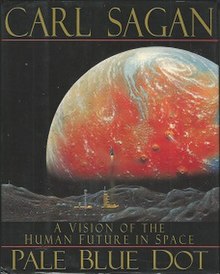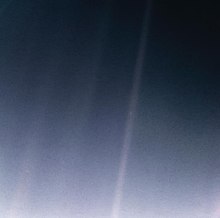
Ann Druyan is an Emmy and Peabody Award-winning American documentary producer and director specializing in the communication of science. She co-wrote the 1980 PBS documentary series Cosmos, hosted by Carl Sagan, whom she married in 1981. She is the creator, producer, and writer of the 2014 sequel, Cosmos: A Spacetime Odyssey and its sequel series, Cosmos: Possible Worlds, as well as the book of the same name. She directed episodes of both series.

Carl Edward Sagan was an American astronomer and science communicator. His best known scientific contribution is his research on the possibility of extraterrestrial life, including experimental demonstration of the production of amino acids from basic chemicals by radiation. He assembled the first physical messages sent into space, the Pioneer plaque and the Voyager Golden Record, which were universal messages that could potentially be understood by any extraterrestrial intelligence that might find them. He argued in favor of the hypothesis, which has since been accepted, that the high surface temperatures of Venus are the result of the greenhouse effect.
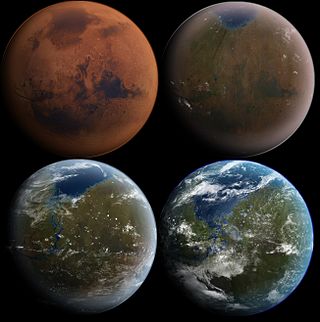
Terraforming or terraformation ("Earth-shaping") is the hypothetical process of deliberately modifying the atmosphere, temperature, surface topography or ecology of a planet, moon, or other body to be similar to the environment of Earth to make it habitable for humans to live on.

The Voyager Golden Records are two identical phonograph records, one of each which was included aboard the two Voyager spacecraft launched in 1977. The records contain sounds and images selected to portray the diversity of life and culture on Earth, and are intended for any intelligent extraterrestrial life form who may find them. The records are a time capsule.

The Blue Marble is a photograph of Earth taken on December 7, 1972, from a distance of around 29,400 kilometers from the planet's surface. Taken by the crew of the Apollo 17 spacecraft on its way to the Moon, it is one of the most reproduced images in history. The image has the official NASA designation AS17-148-22727.

The Vision for Space Exploration (VSE) was a plan for space exploration announced on January 14, 2004 by President George W. Bush. It was conceived as a response to the Space Shuttle Columbia disaster, the state of human spaceflight at NASA, and as a way to regain public enthusiasm for space exploration.

Space and survival is the idea that the long-term survival of the human species and technological civilization requires the building of a spacefaring civilization that utilizes the resources of outer space, and that not doing this might lead to human extinction. A related observation is that the window of opportunity for doing this may be limited due to the decreasing amount of surplus resources that will be available over time as a result of an ever-growing population.

Pale Blue Dot is a photograph of Earth taken on February 14, 1990, by the Voyager 1 space probe from an unprecedented distance of approximately 6 billion kilometers, as part of that day's Family Portrait series of images of the Solar System.

Carolyn C. Porco is an American planetary scientist who explores the outer Solar System, beginning with her imaging work on the Voyager missions to Jupiter, Saturn, Uranus and Neptune in the 1980s. She led the imaging science team on the Cassini mission in orbit around Saturn. She is an expert on planetary rings and the Saturnian moon, Enceladus.
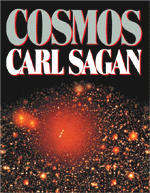
Cosmos is a popular science book written by astronomer and Pulitzer Prize-winning author Carl Sagan. It was published in 1980 as a companion piece to the PBS mini-series Cosmos: A Personal Voyage with which it was co-developed and intended to complement. Each of the book’s 13 illustrated chapters corresponds to one of the 13 episodes of the television series. Just a few of the ideas explored in Cosmos include the history and mutual development of science and civilization, the nature of the Universe, human and robotic space exploration, the inner workings of the cell and the DNA that controls it, and the dangers and future implications of nuclear war. One of Sagan's main purposes for both the book and the television series was to explain complex scientific ideas in a way that anyone interested in learning can understand. Sagan also believed the television was one of the greatest teaching tools ever invented, so he wished to capitalize on his chance to educate the world. Spurred in part by the popularity of the TV series, Cosmos spent 50 weeks on the Publishers Weekly best-sellers list and 70 weeks on the New York Times Best Seller list to become the best-selling science book ever published at the time. In 1981, it received the Hugo Award for Best Non-Fiction Book. The unprecedented success of Cosmos ushered in a dramatic increase in visibility for science-themed literature. The success of the book also served to jumpstart Sagan's literary career. The sequel to Cosmos is Pale Blue Dot: A Vision of the Human Future in Space (1994).
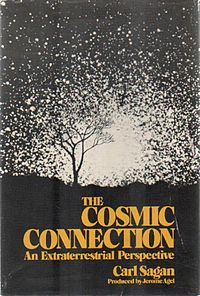
The Cosmic Connection: An Extraterrestrial Perspective is a book by the astronomer Carl Sagan, produced by Jerome Agel. It was originally published in 1973; an expanded edition with contributions from Freeman Dyson, David Morrison, and Ann Druyan was published in 2000 under the title Carl Sagan's Cosmic Connection. The book contains artwork by Jon Lomberg and other artists. The book was listed as number thirteen in a list of the "25 Greatest Science Books of All Time" by Discover Magazine in 2006.
The Family Portrait, or sometimes Portrait of the Planets, is an image of the Solar System acquired by Voyager 1 on February 14, 1990 from a distance of approximately 6 billion kilometers from Earth. It features individual frames of six planets and a partial background indicating their relative positions. The picture is a mosaic of 60 frames. The frames used to compose the image were the last photographs taken by either Voyager spacecraft. The frames were also the source of the famous Pale Blue Dot image of the Earth. Astronomer Carl Sagan, who was part of the Voyager imaging team, campaigned for many years to have the pictures taken.

David H. Grinspoon is an American astrobiologist. He is Senior Scientist at the Planetary Science Institute and was the former inaugural Baruch S. Blumberg NASA/Library of Congress Chair in Astrobiology for 2012–2013.
The Eugene M. Emme Award is an award given annually to a person or persons selected by a panel of reviewers from the American Astronautical Society History Committee to recognize "the truly outstanding book published each year serving public understanding about the positive impact of astronautics upon society." The award is in honor of Eugene M. Emme, NASA's first historian.

Discovery and exploration of the Solar System is observation, visitation, and increase in knowledge and understanding of Earth's "cosmic neighborhood". This includes the Sun, Earth and the Moon, the major planets Mercury, Venus, Mars, Jupiter, Saturn, Uranus, and Neptune, their satellites, as well as smaller bodies including comets, asteroids, and dust.

The Voyager Golden Record contains 116 images and a variety of sounds. The items for the record, which is carried on both the Voyager 1 and Voyager 2 spacecraft, were selected for NASA by a committee chaired by Carl Sagan of Cornell University. Included are natural sounds, musical selections from different cultures and eras, spoken greetings in 59 languages, human sounds like footsteps and laughter, and printed messages from President Jimmy Carter and U.N. Secretary-General Kurt Waldheim.

The Day the Earth Smiled is a composite photograph taken by the NASA spacecraft Cassini on July 19, 2013. During an eclipse of the Sun, the spacecraft turned to image Saturn and most of its visible ring system, as well as Earth and the Moon as distant pale dots. The spacecraft had twice taken similar photographs in its previous nine years in orbit around the planet. The name also refers to the activities associated with the event, as well as to the photographic mosaic created from it.
"Unafraid of the Dark" is the thirteenth and final episode of the American documentary television series Cosmos: A Spacetime Odyssey and its series finale. It premiered on June 8, 2014, on Fox and aired on June 9, 2014, on the National Geographic Channel. The episode was written by Ann Druyan and Steven Soter, and directed by Ann Druyan, making this her series directorial debut. The episode explores the mysteries of dark energy and dark matter, as well as the contributions and theories of Swiss astronomer Fritz Zwicky, who furthered our understanding of "supernovae, neutron stars and 'standard candles.'" The finale reveals a recording of life on Earth - the final message on the golden record of the space probe, Voyager. The episode ends with Carl Sagan's iconic speech on Earth as the "Pale Blue Dot."
The Carl Sagan Institute: Pale Blue Dot and Beyond was founded in 2014 at Cornell University in Ithaca, New York to further the search for habitable planets and moons in and outside the Solar System. It is focused on the characterization of exoplanets and the instruments to search for signs of life in the universe. The founder and current director of the institute is astronomer Lisa Kaltenegger.

Wanderers is a 2014 Swedish science fiction short film created by the digital artist and animator Erik Wernquist. The film depicts actual locations in the Solar System being investigated by human explorers, aided by hypothetical space technology. Of the film's fifteen scenes, Wernquist created some using solely computer graphics, but most are based on actual photographs taken by robotic spacecraft or rovers combined with additional computer-generated elements.
